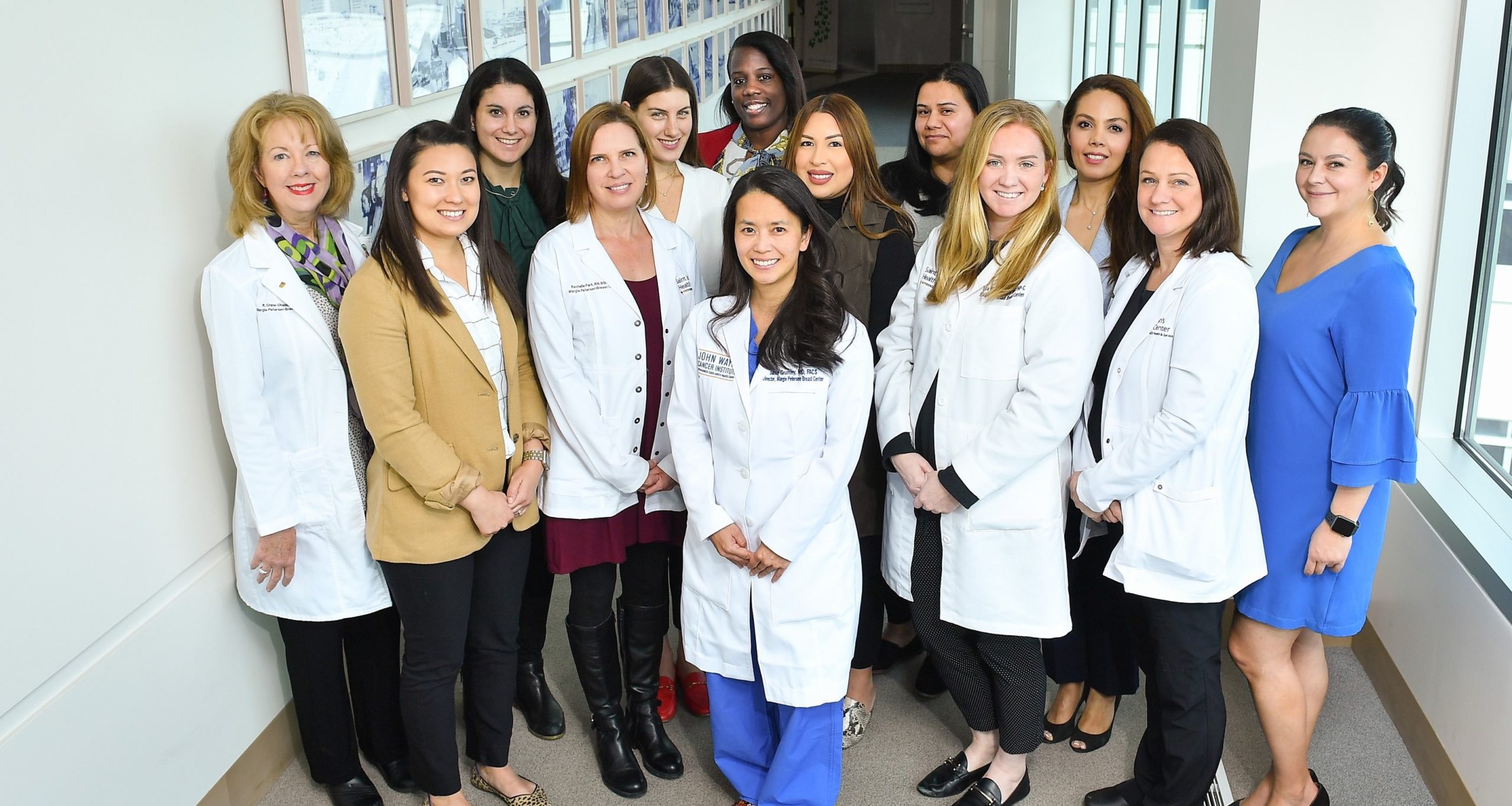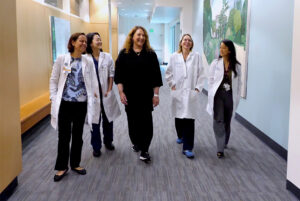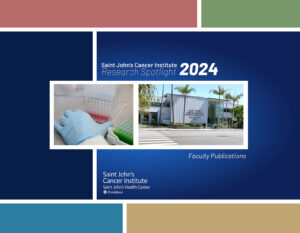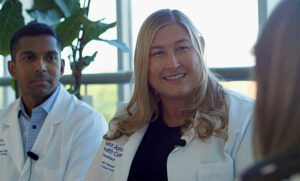The fellowship-trained breast surgeons at Providence Saint John’s Health Center offer the most advanced surgical breast techniques available, including oncoplastic lumpectomy/partial mastectomy surgery, extreme oncoplastic surgery, sentinel node biopsy, and skin-sparing and nipple-sparing mastectomy with breast reconstruction. At the Margie Peteresent Breast Center, we aim to treat the person, not just the disease, mindful of how she feels after her surgery.
The decision to have breast reconstruction after a mastectomy is a personal choice. Many factors contribute to this decision, including medical and surgical aspects such as diagnosis, chemotherapy, or radiation therapy, as well as psychosocial factors like emotional well-being, a sense of self, and a desire to feel ‘whole again.’
What is Breast Reconstruction?
Breast reconstruction is a surgical procedure to recreate the shape of a breast after a mastectomy. It can be done using implants, autologous tissue (tissue from another part of your body), or a combination of both. The goal is to restore the breast to near-normal shape, appearance, and size.
Timing of Breast Reconstruction
Many factors can influence the timing of breast reconstruction. The ideal time is best determined by consulting with your breast and plastic surgeons. For some patients, starting reconstruction right away helps reduce the trauma of losing a breast; immediate reconstruction also eliminates the need for additional hospitalization and anesthesia. For others, particularly those who need radiation, reconstruction is delayed. During your plastic surgery consultation, your diagnosis, medical and social history, and the current status of your cancer treatment will be discussed. Your goals for reconstruction (symmetry in a bra or bathing suit, for example), as well as options available to you, will be addressed. This consultation can help you decide if reconstruction is the right choice for you.
Types of Breast Reconstruction
Implant-Based Reconstruction
Tissue Expander/Implant
Recreating a breast after mastectomy can be accomplished by placing a temporary tissue expander under the skin and chest muscle. The tissue expander has a tiny valve into which a salt-water solution can be injected to stretch the skin over time. After the tissue expander is fully expanded to its desired volume, another procedure is required to exchange this for a permanent saline or gel-filled implant.
Direct to Implant
In select patients, this procedure is possible. Direct-to-implant reconstruction eliminates the need for the placement of an expander. An implant may be placed under the muscle at the time of mastectomy.
Autologous Tissue Reconstruction
Free Flap Procedures
One type of autologous tissue reconstruction is a microsurgical transfer called a free flap procedure. The transferred flap can come from a patient’s abdomen, inner thigh, or buttocks, depending on available tissue and patient preference. In the free flap procedure, the tissue is completely disconnected from the donor site and reattached at the chest. Since the surgeon often needs to use an operating microscope to sew together small blood vessels from the flap to blood vessels at the chest (microsurgery), an expert surgical team is required. This is available through the Margie Petersen Breast Center.
The most common site of tissue used is the lower abdomen. The tissue removed is done in such a way as to preserve muscle function and results in an appearance similar to that of a “tummy tuck.” This procedure is commonly called a DIEP or DIEAP (Deep Inferior Epigastric Perforator or Deep Inferior Epigastric Artery Perforator) flap reconstruction.
Latissimus Dorsi Flap
Another method of reconstruction using your tissue is a latissimus dorsi flap. In this procedure, skin, fat, and muscle from your back are used and moved to the front of your chest, usually to cover an implant or tissue expander.
Nipple-Areola Reconstruction After Mastectomy
For those who have had the nipple and areola removed at the time of mastectomy, reconstruction of the nipple and areola is possible. Several techniques are available and will be discussed with the plastic surgeon and your breast surgeon.
Federal law mandates insurance coverage of the expenses of breast reconstruction and operations to make the opposite breast more balanced in size and shape. Your plastic surgeon and breast surgeon have staff to address the insurance and financial aspects of reconstruction.
Follow-Up Care and Rehabilitation
After breast reconstruction, follow-up care is essential to monitor your recovery and address any complications. Regular check-ups with your plastic surgeon will ensure that the reconstructed breast is healing correctly and that any issues are promptly addressed.
Psychological and Emotional Support
Breast reconstruction can have a significant impact on your emotional well-being. Support groups, counseling, and connecting with others with similar experiences can provide valuable emotional support during your recovery journey. Learn more about our Support Services and Wellness Programs.
FAQs on Breast Reconstruction
What are the different types of breast reconstruction available?
Patients often want to understand their options to make an informed decision. Knowing the different types of reconstruction (implant-based vs. autologous tissue) helps them weigh the pros and cons of each method.
How long does the breast reconstruction process take?
Understanding the timeline for reconstruction, including initial surgery, recovery, and any additional procedures, helps patients and their family manage the recovery period. This is crucial for managing expectations and coordinating with their personal and professional lives.
What are the risks and complications associated with breast reconstruction?
Patients must be aware of potential risks and complications to make an informed decision. Knowing what to expect can help them prepare mentally and physically for the surgery and recovery process.
Will my reconstructed breasts look and feel natural?
Concerns about the aesthetic and tactile outcomes of reconstruction are common. Patients want to know how closely the reconstructed breast will resemble a natural breast in terms of appearance and sensation. At Margie Peteresen Breast Center, our goal is to provide a wealth of information, helping you gain confidence in making the best decision for you.
How will breast reconstruction affect my cancer treatment?
Patients undergoing cancer treatment need to understand how reconstruction might impact their overall treatment plan. This includes considerations for timing, potential delays, and interactions with therapies like radiation or chemotherapy.
What is the recovery process like after breast reconstruction?
Knowing what to expect during recovery, including pain management, physical limitations, and follow-up care, helps patients prepare for the post-surgery period and ensures they have the necessary support.
Will my insurance cover the cost of breast reconstruction?
Financial concerns are significant for many patients. Understanding insurance coverage and any out-of-pocket expenses helps alleviate stress and allows patients to plan accordingly. We can help guide you through this process.
Contact the Margie Petersen Breast Center

The Margie Petersen Breast Center at Providence Saint John’s Health Center is widely renowned for its outstanding and compassionate patient care, expert surgical and medical team, and ability to evaluate any breast condition in one day fully.
Meet Our Breast Health Experts
The Breast Health Clinic can be reached at (310) 582-7209. If you have questions regarding a new symptom or want to make an appointment for evaluation please call and a staff member will assist with navigating you in the right direction.





